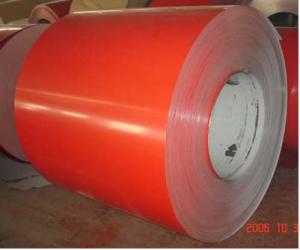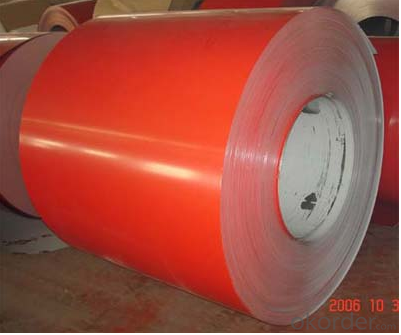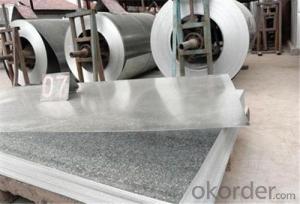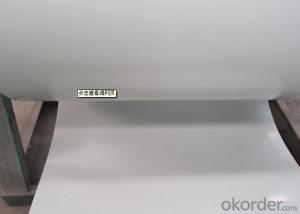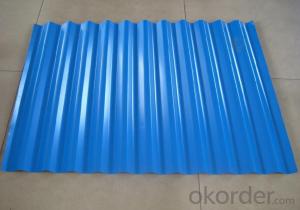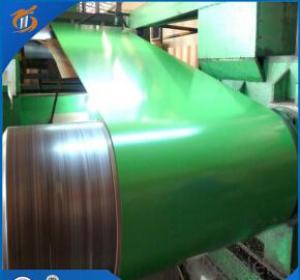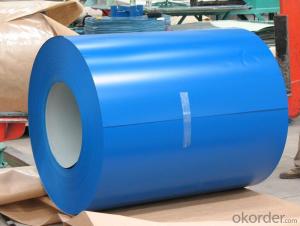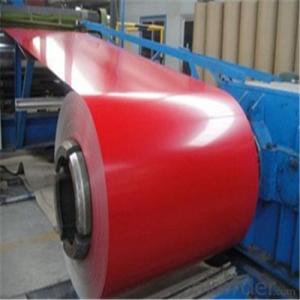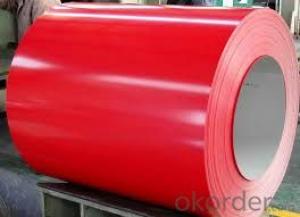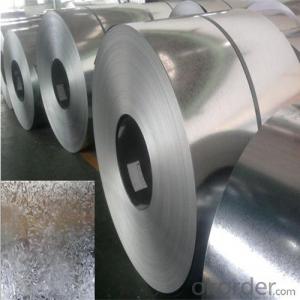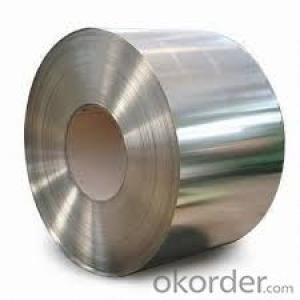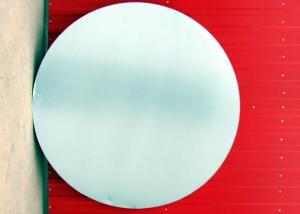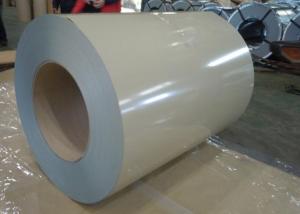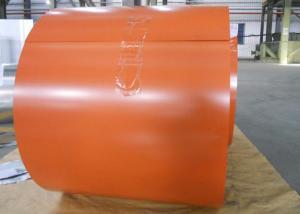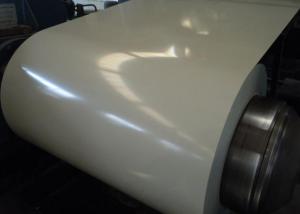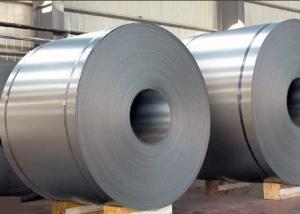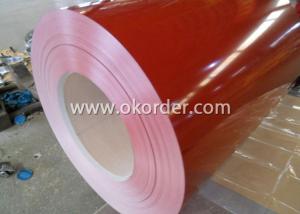Pre-Painted Color Coated Galvanized/Prepainted Cold Rolled Galvanized Steel Coil
- Loading Port:
- China main port
- Payment Terms:
- TT OR LC
- Min Order Qty:
- 100 m.t.
- Supply Capability:
- 1000000 m.t./month
OKorder Service Pledge
OKorder Financial Service
You Might Also Like
Product Description
Prepainted Galvanized Steel Coil PPGI Steel Coil
1) Quality standard of Prepainted Galvanized Steel Coils: JIS G3312 CGCC & CGLCC
2) Grade of Prepainted Galvanized Steel Coils: CGCC and CGLCC
3) Hardness of Prepainted Galvanized Steel Coils: Both soft and hard quality are available
4) Surface finish of Prepainted Galvanized Steel Coils: With or without protect film
5) Thickness of Prepainted Galvanized Steel Coils: 0.14-1.20 mm
6) Width of Prepainted Galvanized Steel Coils: 914mm, 1000mm, 1220mm and 1250mm, width 600-1250mm is available
7) Finish by coil or sheet for Prepainted Galvanized Steel Coils: Both sheet and coil are available
8) Zinc coating of Prepainted Galvanized Steel Coils: 60-275G/M2, both sides
9) Paint thickness for top side of Pre-painted Galvanized Steel Coils: 5 micron primer + (10-20) microns modified polyester, any RAL color code.
10) Paint thickness for back side of Pre-painted Galvanized Steel Coils: (5-10) microns Epoxy
11) Weight per Pre-painted Galvanized Steel Coils: 4-6 tons, also can be upon customer's requirements
12) Max loading weight in one 20ft container for Pre-painted Galvanized Steel Coils: 25 tons generally
13) MOQ of prepainted steel coils: 25 tons for each item;
14) Actual shipping quantity of Pre-painted Galvanized Steel Coils: More or less 10% generally;
15) Delivery time for Galvanized Steel Coils: 15 days ganerally.
16) Applications of Galvanized Steel Coils: Widely used for roofs, outer walls, ovens, explosive-proof steel, electrically controlled cabinets, and industrial freezers in the residential and industrial buildings.
Aluzinc
Color: RAL, or other series
Standard: JIS G3302, JIS G3312, ASTM A653M/A924M 1998
Prepainted Steel Coil Features Specifications:
Grade: Q195 - Q235 and 08AL, SPCC, SPCD, SPCE, 08.10.15, SGCC (DX51D+Z) SGCD(DX52D+Z) etc.
Surface treatment: Chromated, unoiled/oiled, bright finished, spangle, fingerprint resistance.
Surface protection: PE, PVDF, SMP, HDP, etc.
Thickness: 0.20mm-2.0mmWidth: 1000mm, 1200mm, 1250mm, 1500mm, or according to your request.
Zinc coating: 80g-275gsmcoil weight: 3-27 tons
Paint: Polyester silicon modified polyester, PVC sol, polyvinylidene chloride.
Exact Rate As Per Your Request.
We Attach Colour Card In Pic, So It Is For Your Reference.
Back painting: | 5-7 mic. EP |
Color: | According to RAL standard |
commodity | Color-coated Galvanized Steel Coil (PPGI/ PPGL) |
Techinical Standard: | JIS G3302-1998, EN10142/10137, ASTM A653 |
grade | TSGCC, TDX51D / TDX52D / TS250, 280GD |
Types: | For general / drawing use |
Thickness | 0.14-1.0mm(0.16-0.8mm is the most advantage thickness)) |
Width | Width: 610/724/820/914/1000/1200/1219/1220/1250mm |
Type of coating: | PE, SMP, PVDF |
Zinc coating | Z60-150g/m2 or AZ40-100g/m2 |
Top painting: | 5 mic. Primer + 15 mc. R. M. P. |
ID coil | 508mm / 610mm |
Coil weight: | 4--8MT |
Package: | Properly packed for ocean freight exportation in 20' ' containers |
Application: | Industrial panels, roofing and siding for painting / automobile |
Price terms | FOB, CFR, CIF |
Payment terms | 20%TT in advance+80% TT or irrevocable 80%L/C at sight |
delivery time | 25 days after recepit of 20% TT |
Remarks | Insurance is all risks |
MTC 3.1 will be handed on with shipping documents | |
|
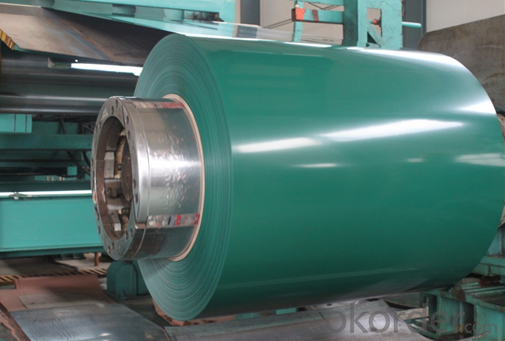
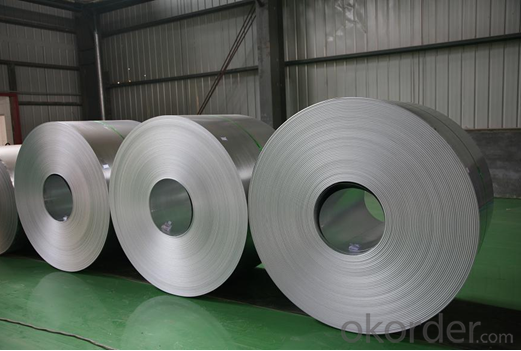
FAQ
1.What's your MOQ?
25MT, it is for one container.
2.Do you have QC teams?
Yeah, sure, our QC team is very important, they will keep the quality control for our products.
3. What's your normal delivery time?
Our delivery time about 10-20days for standard sizes, if you have other requirements like hardness and width ,it is about 20-40days. But don't worry ,we also try our best for the delivery time ,because time longer and our cost is higher.
- Q: Molton is formed at 2800 F. Thats a fact. Now jet fuel at its hottest is 1800. Where does the other 1000 degress come in? And it was found at the WTC 7 site. Was this hit by a plane? A simple fire COULD NOT produce molton. This is a fact. Molton is formed during controlled demoliton of a building since all the bombs in the buiding go off and its very very hot. The fact there was MOLTON at the site is shocking to some since it is IMPOSSIBLE for molton to form from jet feul alone. Impossible. It needed another source. Now the claim that I'll get is that it weakened the stell but then we would find weak steel not molton. Why do you seem to throw this off of your shoulder? Do you not want to belive it? I'm no jet fuel guy but I know you cannot make molton by using just jet fuel. This is really proof that 9/11 was an inside job.
- WTC 7 was not built with a central core like the two big towers were, which allowed it to come down a lot easier than the other two. And the planes didn't have to melt the steel structure holding up the buildings, all they had to do was weaken these structures to where they could no longer hold the weight. RE: Ok fine, since this is what you claim, where are the actual proven facts for this molten steel? Because I have noticed you have no link to a legitimate source available. Still no links to anything legitimate. And 2 thumbs down? Wow, I must be special.
- Q: Steel seems to be much less expensive. What is the reason why? I've heard steel will ruin a barrel after time....is that true? But with the price difference maybe it don't matter? Is steel reliable? What are the negatives about steel I should know before buying?
- Steel is a far more common thus cheaper metal than brass which is made of copper and zinc. The steel case stays in the firing chamber so does not do a thing to the barrel. It does have a different coefficient of expansion and when the gun gets hot it could jam in the chamber more than brass. Some of the steel has a lacquer coating on it that could gum up the works. The biggest disadvantage with steel is that as it is worked it gets weaker so reloading it is not real practical as you will get a lot of blown cases and head separations. In the long run you come out ahead buying brass and reloading than you do buying steel and throwing it away.
- Q: Hello people.Me and the life mate have been working on a fantasy book together and we are currently in the process of outlining the cultures. The culture of our antagonists' is a sort of woodland tribal/celtic[ish] deal and they are very nature oriented. Being a detail freak and wanting to have some real world credibility in the story, I am trying to decide how they produce steel. I want steel to be an important part of the culture, but a thing that is in limited supply. I also do not want there to be a large amount of resources committeded to mining or processing iron ore for steel. So does anyone have any real world ideas explaining how the people can produce steel without using underground mining operations, large processing facilities, and without raping the land?All help and ideas are appreciated
- Well, steel is just modified iron, so you're going to have to start with acquiring the iron first. For that, you're most likely going to be using some sort of underground mining somewhere - either they do that themselves, or they purchase the iron elsewhere. Assuming you're not dealing with meteoric iron (which is possible, but pretty uncommon), or iron sands (not likely in a woodland area), then unless you're dealing with a rocky outcropping with iron veins out in the open, I'm pretty sure there needs to be somebody doing some digging. That said, it doesn't need to be a full raping of the land scenario. A couple of minor mines, some small-scale smelting operations, and somebody knowing the secret of making steel, and it could give you small amounts of steel without making an ecological disaster.
- Q: What are the dimensions of steel coils used in shipbuilding?
- The dimensions of steel coils used in shipbuilding vary depending on the specific requirements of the ship being built. However, common dimensions for steel coils in shipbuilding typically range from 2-15 mm in thickness and 600-2000 mm in width.
- Q: I'm pretty sure that this topic has been beaten to death by now. But, I still can't get a definite answer. With stainless steel, you get better corrosion resistance, and you will hold and edge longer. With carbon steel, you will hold a sharper edge, and you could forge a knife blade longer than 2 ft without breakage. I'm personally a fan of stainless steel ( the 440 grade stuff ), just because it seems to hold up to use and abuse better in the long run. HOWEVER, I have NEVER had a factory made knife break on me. I don't think that they would try to sell you a knife that didn't do what it was meant to do, at least to a reasonable degree. (I work for a living, and can't afford a custom $600 knife.) What do you think? Is this a pointless topic? Will there ever be a winner?
- If your talking about a folding pocket knife, I think that it's basically six one way and a half dozen the other. I actually do prefer stainless for my pocket knives. I don't want to oil a knife to the degree I feel carbon requires, only to then stick it my pocket to attract dirt to the knife and oil to my pants. I'm the exact opposite on sheath knives though. I like 1095 carbon steel, plain edge sheath knives. I'll thrash on them HARD, and I rarely have major edge problems. Of course, I require them to be coated with some kind of powder coat or the like, because they can rust, but I do try and keep them clean and dry when in the sheath, so they won't pit the uncoated edge. My reasons for this sheath knife preference is multi-fold. First, these knives are simply affordable. I don't spend $80 dollars on a outdoors sheath knife. I use the tool too hard to want to spend more. I don't like the more traditional stainless steels such as AUS-8, 420HC, and 440C (not to mention the HORRENDOUS 440A) because I feel that the all else being equal, a stainless blade will bend before a carbon blade will break. I also think that carbon holds an edge at least as well, if not better, than traditional stainless, and it's much easier to hone. I don't know much about these new laminates, other than the very hard, but not so tough. They seem to be POSSIBLY too brittle for my use. That, combined with the fact that they cost a FORTUNE, means that I just won't be considering them.
- Q: How are steel coils processed and shaped into different products?
- Steel coils are processed and shaped into different products through a series of manufacturing techniques. First, the coils are uncoiled and straightened to remove any deformities. Then, they go through processes like cutting, slitting, or shearing to achieve the desired width and length. Next, the steel is shaped using techniques like rolling, bending, or stamping to create specific profiles, such as sheets, plates, or tubes. Additionally, various heat treatments and surface finishes can be applied to enhance the strength, durability, and appearance of the steel products. Overall, a combination of mechanical, thermal, and chemical processes is employed to transform steel coils into the wide range of products we see in industries like construction, automotive, and manufacturing.
- Q: What are the common coil diameters available for steel coils?
- Steel coils come in a range of common diameters depending on the industry and purpose. Generally, the most frequently used coil diameters for steel range from 24 inches to 72 inches. These diameters are commonly utilized in sectors like automotive, construction, and manufacturing. It should be noted that the required coil diameter might vary depending on factors such as the material's size and weight, the equipment used for coil handling, and the specific requirements of the end-use application.
- Q: How do steel coil manufacturers handle customer complaints?
- Steel coil manufacturers handle customer complaints by following a structured process to address and resolve the issues raised by customers. Firstly, when a customer complaint is received, it is important for the manufacturer to carefully listen and understand the nature of the complaint. This involves actively engaging with the customer to gather all relevant details and information regarding the issue. It is crucial to maintain clear communication and ensure the customer feels heard and valued. Once the complaint has been fully understood, the manufacturer should promptly investigate the situation. This may involve reviewing production records, analyzing quality control measures, or conducting internal inspections. The aim is to identify the root cause of the problem and determine if it was a result of a manufacturing defect, shipping mishap, or any other factor. After the investigation, the manufacturer should provide a timely response to the customer. This response should include an explanation of the findings, an acknowledgment of the customer's concerns, and a proposed solution or resolution. The proposed solution might involve replacing the defective coils, offering compensation, or providing expert advice on how to mitigate the issue. To prevent similar complaints in the future, the manufacturer should also take steps to rectify any internal shortcomings. This could involve revisiting quality control procedures, improving communication among departments, or implementing additional training for employees. Furthermore, steel coil manufacturers should strive to maintain an open and transparent line of communication with customers throughout the complaint handling process. This includes providing regular updates on the progress of the investigation and promptly addressing any further concerns or questions raised by the customer. Overall, the key to handling customer complaints in the steel coil manufacturing industry is to prioritize customer satisfaction and ensure a fair and efficient resolution. By following a structured approach, actively listening to customers, and taking appropriate corrective actions, manufacturers can effectively address customer complaints and maintain positive relationships with their clients.
- Q: How are steel coils used in the production of metal buildings?
- Steel coils are an essential component in the production of metal buildings as they are used to create the structural framework and outer cladding. These coils are unrolled and cut into sheets, which are then shaped and formed into various building components such as beams, columns, and panels. The strength and durability of steel make it an ideal material for constructing metal buildings, ensuring they are capable of withstanding harsh weather conditions and providing long-lasting structures.
- Q: Can steel coils be used in marine environments?
- Yes, steel coils can be used in marine environments, but proper precautions need to be taken to prevent corrosion. Steel is prone to corrosion when exposed to moisture and saltwater, which are common in marine environments. To counteract this, the steel coils can be treated with protective coatings, such as galvanization or painting, to create a barrier between the steel and the corrosive elements. Additionally, regular maintenance and inspections should be performed to identify any signs of corrosion and take appropriate action to prevent further damage. By implementing these measures, steel coils can be effectively used in marine environments while minimizing the risk of corrosion and ensuring their durability and performance.
Send your message to us
Pre-Painted Color Coated Galvanized/Prepainted Cold Rolled Galvanized Steel Coil
- Loading Port:
- China main port
- Payment Terms:
- TT OR LC
- Min Order Qty:
- 100 m.t.
- Supply Capability:
- 1000000 m.t./month
OKorder Service Pledge
OKorder Financial Service
Similar products
Hot products
Hot Searches
Related keywords
